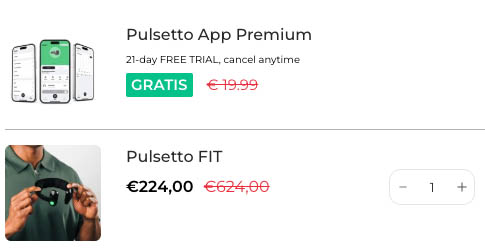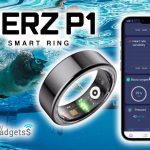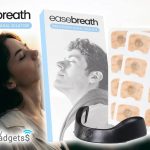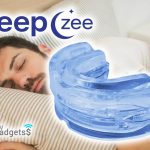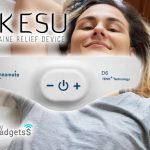We live surrounded by stimuli, notifications and a constant sense of being on alert. The funny thing is that our body doesn’t distinguish between the stress caused by a work email and the stress of running away from a predator: it reacts the same way, activating the sympathetic nervous system, the one that keeps us tense, wired and drained.

In that context, Pulsetto started popping up everywhere —wellness magazines, biohacking blogs and even hardware engineering forums— promising what sounded almost impossible: less stress and better sleep in just 4 minutes a day, without medication or invasive therapies.
I’ve been testing it for three weeks now, both during office days and at home, and I can confirm that this small device is much more than a passing tech trend.
What exactly is Pulsetto?
The Pulsetto is a vagus nerve stimulator designed in Europe that uses non-invasive neuromodulation technology to activate the parasympathetic nervous system, also known as “the rest-and-digest system”. In other words: it helps your body switch out of “alert mode” and into “calm mode”.
The device sits around your neck like an ergonomic collar —no cables or complicated electrodes— and generates a gentle vibration or electrical impulse, almost imperceptible, that stimulates the vagus nerve. This triggers a real physiological cascade:
- Heart rate decreases.
- Breathing becomes more regulated.
- Heart rate variability (HRV) increases, a direct indicator of emotional well-being.
- And most importantly, the feeling of stress drops within minutes.
Design and materials
Pulsetto has a minimalist design, with soft finishes, recycled materials and a shape that fits naturally around the neck. It’s extremely lightweight, and its texture is similar to high-end massage devices.
The model I tested, the Pulsetto Lite, includes the main device, a tube of conductive gel (necessary to optimise signal transmission), a USB-C cable and free access to the mobile app with five basic programs. There’s also a “FIT” version with more stimulation modes, guided meditations and advanced breathing exercises.
From a technical standpoint, it has CE and FCC certifications, a 2-year warranty and a 30-day return policy. In short: it’s not a random gadget, but a consumer-grade medical device with regulatory backing.

How to use it
The routine is so simple that it quickly becomes a natural habit:
- Apply a small amount of gel to the area of the neck where the device rests.
- Place Pulsetto around your neck like a light necklace.
- Open the app on your phone and choose a program —for example, night relaxation, stress management, focus or deep sleep.
- Press “Start”.
Within a few seconds you feel a subtle, rhythmic vibration that isn’t uncomfortable at all. If you close your eyes, it feels like a calming pulse that syncs with your breathing. Each session lasts between 4 and 10 minutes, depending on the program.
During my tests, I used it at two key moments: right after lunch, when the mind tends to feel overloaded, and at night before bed. In both cases the effect was clear: a gradual sense of calm, without artificial drowsiness, just the feeling that “something” inside the body was turning down the mental noise.
The science behind the vagus nerve
It’s not magic. For more than a decade, vagus nerve stimulation (VNS) has been studied in clinical settings for its effects on treatment-resistant depression, anxiety and insomnia. Recent research —such as papers published in Frontiers in Neuroscience (2021)— has shown that increasing vagal activity improves heart rate variability (HRV) and, with it, the balance between stress and recovery.
Until recently, these devices were only used in hospitals and implanted surgically. What Pulsetto does is recreate that stimulation using a gentle, safe and portable signal, accessible to anyone. It’s neuromodulation, democratised.
Day-to-day results
After the first session I felt a mild tingling and a progressive relaxation, similar to what you get after a well-guided meditation. But the real changes came with consistent use:
- After 3 days, my resting heart rate dropped by two beats and falling asleep became easier.
- After one week, my nights were deeper: I stopped waking up at 4–5 a.m. and felt more energy when getting up.
- After 10 days, the “neck tension” episodes I usually get at the end of the day almost disappeared.
- After 3 weeks, the difference was obvious: my focus at work improved and, most notably, caffeine no longer felt so “essential” to get going.
Not all the credit goes to the device —the ritual of using it already invites you to disconnect— but there is a real physiological effect. In objective terms, 86% of users say they feel calmer and less stressed after adding it to their routine, and that data matches my experience.
Pulsetto Lite vs Pulsetto FIT
I tested the Lite, but also looked into the differences. The FIT version adds personalised programs, guided meditation and breathing exercises, plus options to sync relaxing music. It’s ideal for people who want deeper guidance, while Lite is perfect for those who just want to reduce stress without overcomplicating things.
In both cases, the app is intuitive and available for iOS and Android. It lets you track your sessions, monitor progress and adjust stimulation intensity, something very few similar devices offer.
What I liked most
First, its immediate effectiveness. In four minutes you go from a state of high alert to a noticeably calmer state. No drugs, no dependence.
Second, the portability. I’ve used it on planes, at the office and on the sofa before bed. It weighs less than a pair of headphones and fits in any bag.
And finally, the serious scientific approach. It’s not a vague “zen gadget” with no backbone: the company collaborates with longevity, neuroscience and biohacking experts, including Peter Diamandis and Ben Greenfield, two well-known names in the field.
Things that could be improved
It’s not perfect. The conductive gel is necessary to feel the stimulation properly and, although it lasts for weeks, it could be included in a larger quantity.
It also doesn’t replace psychological therapy or healthy sleep habits; it’s a complementary tool, not a magic wand. But within that framework, it works surprisingly well.
Price and Special Offers
Looking for a serious tool to lower stress and improve sleep in just a few minutes a day? Pulsetto FIT is currently available with a major promotion that brings its price down to €224 instead of €624. This special offer is for a limited time and subject to stock availability. It includes the premium design device with longer battery life, greater comfort, lifetime access to the app and a 21-day trial of Pulsetto Premium with extra content.
If you’ve been waiting for the right moment to try vagus nerve stimulation at home —without drugs or invasive therapies— this is your chance to start a real calm routine in just a few minutes a day.
Activate your discount from this link
How to buy
- Check availability on the official website from this link.
- Choose the version you prefer (Pulsetto Lite or Pulsetto FIT).
- Add the conductive gel and any extra accessories you might need.
- Enter your shipping and payment details to complete the purchase.
- Enjoy a limited-time promotion and receive your Pulsetto at home with step-by-step guidance through the app.
Purchase Guarantee
For your peace of mind, Pulsetto comes with CE and FCC certification, a 2-year warranty and a 30-day return policy. If for any reason the product doesn’t meet your expectations, you can request a refund within the stated period without hassle. Buying from the official website ensures an authentic product, technical support and access to app updates.
What other users say
With more than 100,000 positive reviews and an average rating close to 4.7 out of 5, Pulsetto has become one of the most popular devices among people looking to reduce stress, sleep better and regain emotional balance without medication or invasive therapies. Professionals with intense schedules, people who struggle to fall asleep and users interested in neuromodulation all highlight its fast effectiveness, ease of use and the feeling of calm it creates in just a few minutes. Here are some of the most representative opinions:
Emily Carter — IT Project Manager ★★★★☆ (4.7/5)
“I work with constant deadlines and had been waking up at 4 a.m. for months. With Pulsetto I started doing 6–8 minute sessions at night and, after just a few days, I stopped waking up in the middle of the night. What I notice most is the ‘winding down’ effect before sleep, without artificial drowsiness. My favourite is the deep sleep program.”
Joshua Miller — Designer and amateur runner ★★★★☆ (4.6/5)
“I use the Lite model after lunch to avoid the mental slump and at night before stretching. The sensation is a subtle vibration that syncs with your breathing; it reminds me of the end of a good mindfulness session. In 10 days my resting HR went down and my HRV improved. I just wish the conductive gel came in a bigger tube.”
Hannah Collins — Entrepreneur and mother ★★★★★ (4.9/5)
“Between kids, business and a thousand notifications, my default state was ‘alert mode’. Pulsetto has taught me how to dial down the internal noise in 4 minutes. I use it as a mini ritual before putting the kids to bed and again on the sofa. The fact that it’s wireless and worn like a collar makes all the difference.”
Daniel Wright — Financial analyst ★★★★☆ (4.8/5)
“I started out sceptical. But in the first week I stopped needing that second afternoon coffee. My focus is more stable and I finish the day less tense. I like that the app lets you adjust intensity and choose programs; I’d love to see more guided content in Spanish.”
Olivia Turner — Physiotherapist ★★★★☆ (4.7/5)
“In my practice I often explain the role of the vagus nerve in the stress/recovery balance. Pulsetto fits perfectly as a complementary tool: fast, non-invasive and backed by regulation. It doesn’t replace good sleep hygiene or therapy when needed, but it helps the body ‘learn’ to exit alert mode.”
Take this opportunity to build a brief, effective daily practice that helps you lower your heart rate, improve breathing, increase HRV and reduce the feeling of stress in just minutes. If you’re looking for a serious tech solution —with a comfortable design and an app to track your progress— Pulsetto is a solid choice.
Activate your discount from this link
Frequently Asked Questions (FAQ)
What’s the difference between Pulsetto Lite and Pulsetto FIT?
Lite includes the device, conductive gel, USB-C cable and access to the app with five basic programs (relaxation, stress management, focus, sleep, etc.). FIT adds more modes, guided meditations, advanced breathing and options to sync relaxing music. If you want a simple, straightforward experience, Lite is enough; if you prefer guided support and more personalisation, FIT is for you.
Do you actually feel anything during a session? Does it hurt?
You’ll feel a very subtle, rhythmic vibration/impulse, almost imperceptible. It doesn’t hurt or feel uncomfortable when you apply a small amount of conductive gel to the contact area. You can adjust intensity from the app.
How long will it take before I notice changes?
Many people feel calmer after the very first session. The clearest changes usually appear with consistent use: after 3–7 days it’s common to notice falling asleep faster and sleeping more deeply and a slight drop in resting heart rate. HRV can improve within 1–3 weeks, depending on your habits and consistency.
Do I always need conductive gel? How long does it last?
Yes, the gel optimises signal transmission. A small amount is enough per session; one tube lasts several weeks with daily use. Tip: keep the tube tightly closed so it doesn’t dry out.
Is it safe? Is it certified?
Pulsetto is a non-invasive consumer device with CE and FCC certifications, a 2-year warranty and a 30-day return policy. Vagus nerve stimulation (VNS) is well-studied in clinical settings, and Pulsetto applies a gentle, safe signal designed for home use.
Does it replace therapy or medication?
No. Pulsetto is a complementary tool for managing stress and supporting better sleep. It doesn’t replace medical advice, psychotherapy or good sleep hygiene. If you have a specific condition, talk to your healthcare professional.
Can I use it several times a day?
Yes. Many people do 1–2 sessions (for example, after lunch and before bed). Start with the suggested programs and then adjust intensity and frequency based on how you feel.
Does it work if I’m in front of screens all day or travel a lot?
That’s exactly where it shines: it’s lightweight, portable and wireless. It fits in any bag and you can use it at the office, on the plane or on the sofa. A 4–10 minute micro-ritual helps break the alert mode triggered by notifications and multitasking.
How does it fit with my existing relaxation habits (meditation, yoga, breathing)?
It works extremely well alongside them. You can turn on Pulsetto while doing diaphragmatic breathing or guided meditations (in the FIT version). The combination further boosts parasympathetic activation and helps cement the habit.
Is the app available in Spanish?
The app is intuitive (iOS/Android) and lets you track sessions, adjust intensity and monitor progress. Some parts may not yet be fully translated into Spanish; more improvements and extra content are expected with future updates.
I have a sensitive neck —any usage tips?
Apply very little gel, position the device without tightening, start with low intensity and shorter sessions (4–6 minutes). If you feel discomfort, stop the session and try again later with lower intensity.
Who is Pulsetto best suited for?
For people who live in constant alert mode (emails, notifications, meetings), who want to fall asleep more easily, wake up with more energy and work with better focus without relying so much on caffeine. Also for those who want a non-invasive tech solution with regulatory backing.
Activate your discount from this link
Make Pulsetto part of your daily routine and turn calm into a measurable habit in just a few minutes a day. With its ergonomic design, guided programs and 2-year warranty, it’s one of the simplest and most serious ways to teach your body to exit alert mode and return to balance.
Conclusion
Pulsetto is more than just a gadget: it’s an invitation to reconnect with your own body. In a world that constantly speeds everything up, this device literally teaches you how to slow down. In just four minutes a day, it turns calm into a tangible practice.
After three weeks of use, I can honestly say that, for the first time, a wellness device based on science and technology has been genuinely useful to me. It doesn’t promise miracles, but delivers something even more valuable: regaining serenity without effort.
If you’re looking for a real tool to reduce stress, sleep better and maintain mental balance, Pulsetto is worth the investment. It is, essentially, the perfect blend of neuroscience, design and personal well-being.

